Telephone commercialization started almost hundreds of years ago, and the whole began communication to one another through the famous and well-known telephone lines. This telecommunications system evolved with undersea telephone wires, communication satellites, underground copper cables, and a digital core network into the Public Switched Telephone Network, as we are familiar with at this point.
On the other hand, the Public Switched Telephone Network or PSTN for short was no match for the development of the internet, and it has been a stable decline for the previous years. Do you want to know what PSTN is? Do you want to know how it works and how it costs? If so, continue reading.
What Is Exactly a PSTN?
Public Switched Telephone Network or PSTN is a conventional circuit-switched telephone network. This telecommunication system has been utilized generally since year 1800s. At first, this telecommunication system did not set out to offer the backbone for new communication infrastructure. As a matter of fact, this system is intended for a standard three minutes call time or less than, depending on limited bandwidth- 64 Kbps over a twisted copper pair cable. This analog structure is called POTS or Plain Old Telephone Service.

In the past years, there are lots of upgrades made to bring PSTN components in the Digital Transformation Services world; the most popular access practice for landline telephones stays this analog system, copper wire connection. The rate for telephone communication operators substituting the copper cable with higher bandwidth media like fiber optic wire is banned, particularly with the development which has been done in a wireless system in present years.
In current years, there is a significant turn down of the landline. This is because people opt for mobile phones as a way to communicate with each other. In the year 2008, a lot of families or residences without a landline stood at 25 percent in the US. However, this number increased by 2014 to 40 percent. That rate is higher amongst those residing in urban places.
What’s More?
Using subversive copper wires, this heritage platform has given households and businesses a dependable way to keep in touch with anyone from all parts of the globe for generations. The phones are called by names like Plain Old Telephone Services or POTS for short, PSTN, fixed-line telephones, or landlines.
PSTN telephones are broadly utilized and still accepted as a normal type of communication. On the other hand, they’ve seen a stable beg off over the last years. As a matter of fact, there are presently only 972M fixed-line phone subscriptions in use all over the world. It is considered the lowest number so far.
How Does the PSTN (Public Switched Telephone Network) Work?
Consider this as the international mishmash of phone lines. It has switching centers, underground wires, cellular networks, which include satellites and cell towers. All these lines, centers, as well as wires or cables, connect each other. Now calls are able to flow smoothly from the destination, via a network, to the receiver’s destination.
Before, an analog call traveled via copper cables, and every call required its own dedicated cable to link a call. Telephone operators would sit on a switchboard and connect cables to connect two telephones a call.
Today, evolution in digital substituted this old system with auto-electronic switching. Now, digital voice signals could share similar cable with other phone calls. Also, today due to fiber optics wire, these are able to link many calls on one shared line and are also a preferred choice for Unified Communication in the organization.

Here is what the route looks like today on the Public Switched Telephone Network
Dial numbers to show how you would want the call to be processed:
Each phone number has a particular function or intention. The first three numbers are the regional switching station or area code. Then, the next three numbers are the exchange, and the last numbers represent the unique phone ID of the recipients that are connected to a particular phone line and address.
Your phone translates the sound from your voice into an electrical signal which is conveyed via wire to the terminal.
The terminal conveys the signal to the CO or central office.
It depends on where calls are going or on your address or place of living; the central office will direct your call to a Central Office, toll office, international gateway as well as tandem office.
- Central Office: If you live in the same area as your receiver, the call will go straight to the central office in your area and connect to the receiver.
- Tandem Office: in case you are calling in another place of a city in a similar province as the receiver, a call would go straight to the CO, then get directed to a tandem office, and then directed to the CO of the recent and lastly directed to the recipient.
- TO or Toll Office: In case you are calling in another province from the recipient, then the TO would connect to a TO that is accountable for long-distance switching, and from there, your call would be switched.
Lastly
- International Gateway: In case you are calling abroad from the recipient, the call will be directed to IG or an international gateway to link the long-distance call.
When your call has been directed to the correct destination, the electrical signal is directed to the TO and then delivered to the appropriate telephone number. The telephone rings, and if the receiver answers the phone, an electrical signal is changed back into sound waves. The process might have been a bit complex; however, it all happens in just a couple of seconds.
How Businesses Can Benefit from Using PSTN

When setting up this system for a company or organization, you would require getting an individual line for every worker or employee. This may work for companies with many employees; however, it will cost a lot to add lines.
That is the reason why bigger and renowned companies utilize PBX or private branch exchange. This system transforms the company telephone system into a CO. Incoming calls reach the Private Branch Exchange, and then they are directed to a worker’s particular extension. Private Branch Exchange makes use of nifty features such as automatic attendants to help callers get to the right destination.
On the other hand, there are other- so-called modern and groundbreaking solutions available out there for companies or businesses. There are some alternatives to Public Switched Telephone Network that every business owner and homeowner alike must think of.
How Much Does PSTN Cost?
If you are asking how much you need to spend if you were to set up and utilize a Public Switched Telephone Network in your office or household?
Cost of PSTN for Consumers
In case you want a PSTN connection system in your residence, you will have to have a phone set as well as a PSTN service provider.
You can purchase a decent telephone set for as low as 60 dollars in various online stores. You can check stores like Walmart or Amazon for high-quality products. The basic telephone service that has unlimited local calls will cost you 30 dollars a month.
Now, if you want a plan that provides unlimited calls, both local and national, you can register for one for only $50 a month. You would be paying $90 to $110 for your first month of subscription, and after that, you will just pay $30 to $50 a month. This is ideal and perfect for one phone line at home.
Also, read how to turn on PSTN conferencing and PSTN Calling in Microsoft Teams.
Microsoft Teams also provides a full phone system integration.
Cost of PSTN for Companies
Things change drastically if you switch to companies. If you have a company and you think a PSTN system is needed, you will require a separate line for every worker. This is why many companies opt for VoIP between PBX Vs VOIP systems rather than the traditional phone system.
If your company has ten workers or lower, you can opt for a month-to-month plan. It will cost you $30 a month for every connection. Of course, you will need to buy telephone sets as well.
If your company has more employees, like, for example, forty, it is advisable to choose or go for KSU or also known as Key System Unit. This option offers the user many extra features that make it a good choice than the typical telephone connection. This will cost you $300 to $800 or more for every line.
Using the Public Switched Telephone Network Today
Today, PSTN is still the leading answer for connecting people across the world via voice communications. Certainly, it’s not the lone solution available. Many of the biggest private telephone networks are not connected to the Public Switched Telephone Network- usually for military purposes. Also, there are an array of exclusive networks operated by big firms, which are associated with the PSTN via limited gateways like PBX.
At this point, connecting the digital app to the PSTN is possible. Like for instance, users of Skype for Business can now utilize MS plug-in, which enables them to call landlines and mobile and other gadgets or computers. There are also cloud PBX solutions, which enable businesses to utilize their office apps normally, at the same time experiencing the perks of a third-party getaway of PSTN.
Fill In The Form For – FREE 30 Mins Microsoft Teams PSTN Consulting










